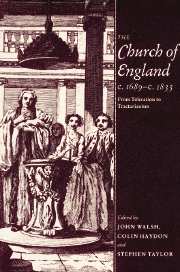Book contents
- Frontmatter
- Contents
- Preface
- List of Abbreviations
- 1 Introduction: The Church and Anglicanism in the ‘long’ eighteenth century
- Part I The pastoral work of the Church
- Part II Crisis and reform
- 5 The Church, the societies and the moral revolution of 1688
- 6 John Locke, Jonas Proast and religious toleration 1688–1692
- 7 The origins and ideals of the SPCK 1699–1716
- 8 Cultural patronage and the Anglican crisis: Bristol c. 1689–1775
- 9 Latitudinarianism at the parting of the ways: a suggestion
- 10 Ecclesiastical policy under Lord North
- 11 The foundation of the Church Missionary Society: the Anglican missionary impulse
- 12 A Hanoverian legacy? Diocesan reform in the Church of England c. 1800–1833
- Part III Identities and perceptions
- Index
5 - The Church, the societies and the moral revolution of 1688
John Spurr
Published online by Cambridge University Press: 13 October 2009
- Frontmatter
- Contents
- Preface
- List of Abbreviations
- 1 Introduction: The Church and Anglicanism in the ‘long’ eighteenth century
- Part I The pastoral work of the Church
- Part II Crisis and reform
- 5 The Church, the societies and the moral revolution of 1688
- 6 John Locke, Jonas Proast and religious toleration 1688–1692
- 7 The origins and ideals of the SPCK 1699–1716
- 8 Cultural patronage and the Anglican crisis: Bristol c. 1689–1775
- 9 Latitudinarianism at the parting of the ways: a suggestion
- 10 Ecclesiastical policy under Lord North
- 11 The foundation of the Church Missionary Society: the Anglican missionary impulse
- 12 A Hanoverian legacy? Diocesan reform in the Church of England c. 1800–1833
- Part III Identities and perceptions
- Index
Summary
‘It is not surprising’, writes D. W. R. Bahlman, ‘to find a movement for the reformation of manners starting in the Church immediately after the revolution [of 1688]’. Other historians have agreed that ‘by the 1690s many Anglicans had come to the conclusion that the reaction against strict attitudes to morals and religion which had accompanied the restoration of Charles II had gone too far, and there took place what was in effect a revival of “puritanism”, in a devotional and moral, rather than in an ecclesiastical sense within the established church’. It has become a commonplace that running alongside the dynastic, constitutional and ecclesiastical revolutions of 1688 was a revolution in expectations about public manners or a ‘moral revolution’ as Bahlman dubbed it. And it has become as firmly accepted that this moral revolution crystallized the pastoral dilemma facing the Church of England. Should the Church accept that she was just another voluntary body competing in the religious free market created by the Toleration Act of 1689? And should she recognize that the secular authority was now the primary agent of moral reformation? Or could she, with political help, resurrect the pastoral and moral control over the nation to which she had aspired since 1662? The quandary of the Church was exposed by her half-hearted involvement in the Societies for the Reformation of Manners (henceforth referred to as SRM), which were only endorsed by the primate in 1699, almost a decade after they were first formed, and by the reactionary and authoritarian demands of the fractious lower house of Convocation.
- Type
- Chapter
- Information
- The Church of England c.1689–c.1833From Toleration to Tractarianism, pp. 127 - 142Publisher: Cambridge University PressPrint publication year: 1993
- 5
- Cited by



